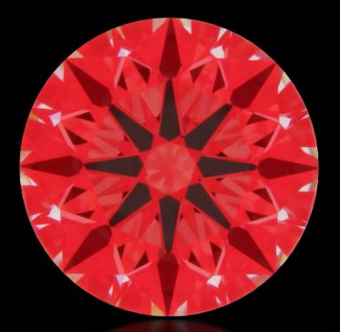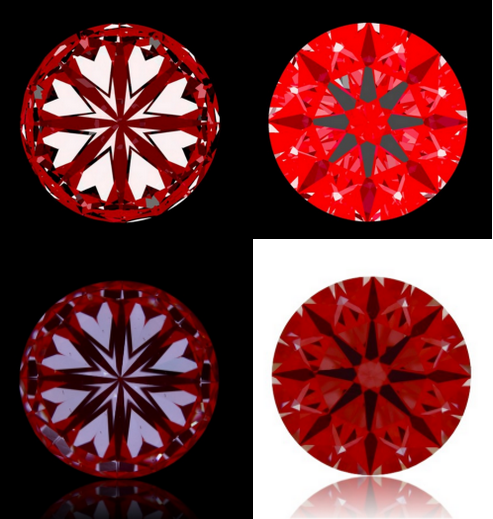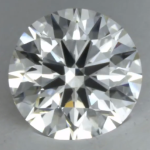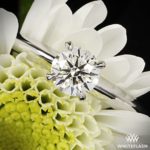Ideal-Scope – Light Return, Light Leakage, and Contrast
The portable ideal-scope is a small glass or plastic viewer surrounded by a black and red plastic funnel that is used to further determine how well a diamond has been cut. The ideal-scope serves as a useful and simple tool to evaluate a diamond’s light return, light leakage, and contrast.
You may use an ideal-scope independently if you are shopping for loose diamonds in person, but the internet buyer can also gain considerable value from ideal-scope images posted online. Many diamond retailers showcase this advanced light performance technology to help the novice consumer understand in simple terms how a particular diamond will reflect light.
When reviewing an ideal-scope image online, you are looking through the crown (top part) of the diamond and trying to determine how well a particular diamond is reflecting light through it’s pavilion (bottom) facets (not crown). These pavilion facets can serve as either mirrors or windows. For example, facets can either reflect light back to your eye in which case they can be referred to as mirrors. When light isn’t bounced back through the crown from the pavilion facets, this light is ‘lost’ and we call this light leakage. Another way of saying this is that some facets serve as windows where the light just passes straight through.
What To Look For In An Ideal-Scope Image

An example of an ‘Excellent’ ideal-scope image with ideal light return, minimal light leakage and excellent contrast.
An ideal-scope image can reflect back various colors including: red, pink, black, clear or white. How these all interplay with each other will determine the diamond’s overall ability to maximize it’s full potential of internal light reflection while still offering distinct contrast. Generally, a viewer can use the following guidelines:
– Red/Black – pavilion facets that are reflecting (mirrors) optimized light
– Light Red/Pink – pavilion facets that are reflecting (mirrors) less optimized light return
– Clear/White – pavilion facets that are leaking (windows) light
When viewing an ideal-scope image the most important color is the amount of red light reflected followed by distinct and symmetrical dark contrast with little to no clear/white light leakage. Every diamond will show some amount of light leakage, but the point is to search for one that offers as little light leakage as possible. Please keep in mind that fancy cut diamonds (anything other than round) will show more light leakage because the shape isn’t geometrically symmetrical. Hence the reason why the round brilliant offers the most possible light return, is the most popular, and is the most expensive.
What Is Light Return?
Light return is another way of saying how well a diamond returns white light back to the observer. It is also referred to as brilliance. If the pavilion facets are correctly proportioned and aligned, then the light entering the crown will be reflected back from the pavilion through the crown, resulting in white light return.
What Is Light Leakage?
Light leakage is when a diamond’s pavilion facets do not reflect light back to through the crown. The result is a dull or lifeless looking diamond. Light leakage is an important consideration because too much of it has a direct impact on a diamond’s overall visual ‘performance’.
What is Contrast?
Fundamentally, diamonds reflect light from their surroundings. If you are looking face-down into the crown of a diamond you are effectively creating a ‘dark’ area that the diamond will then reflect as ‘contrast’ to your eyes (you are obstructing the light source). The perception of visual brightness is further enhanced by contrasting dark areas. Think of a chessboard vs. a plain sheet of white paper. The chessboard will appear visually ‘brighter’ despite the fact that it has more dark areas. Diamonds with a good balance of very bright white light followed by very dark areas appear visually brighter.
Optical Symmetry vs. Light Performance
In round brilliant diamonds, the popular ‘arrows’ dark contrast offers a distinct and crisp contrast pattern which further enhances the perceived brilliance of the diamond. Perfect optical symmetry affects both contrast patterning as well as how well the light is dispersed throughout the diamond. Naturally, diamonds with perfect optical symmetry AND ideal light performance represent an ultra-rare selection of diamonds and are otherwise known as ‘super-ideal’ diamonds. Some retailers specialize in these super rare cuts and are the best authorities on how to select a precision cut diamond.
However, it is important to understand that perfect optical symmetry (otherwise known as hearts and arrows) in a diamond doesn’t necessarily equate to ideal light performance. In fact, it is possible to have a diamond with superior optical symmetry, yet have compromised light performance and vice versa. How can this be? Light performance (or overall white light reflection/brilliance) is determined primarily by a diamond’s pavilion main facets which can either be cut too steep (leak light) or too shallow (too much head/body shadow or dark contrast). The hearts and arrows optical symmetry pattern is created by precise alighnment of all pavilion main, lower girdle, upper girdle, kite and star facets. If any of these are even slightly asymmetrical, the pattern will be uneven or distorted.

Top: An example of a GIA triple Excellent round diamond, with near-perfect hearts pattern but ‘good’ ideal scope image. Bottom: An example of a GIA triple Excellent round diamond with poor hearts image but ‘Excellent’ ideal-scope image. In this case, the bottom diamond will be visually brighter and whiter than the first diamond.
In the above examples you can clearly see two different diamonds. The first 1.21ct J SI1 for $4,530.00 has near-perfect optical symmetry but poor light performance. You can clearly see that under the main table face there is ring of ‘white’ which indicates light leakage through the center. This translates to a duller looking diamond. However, the second 1.20ct J VS1 for $5,670.00 has an unsymmetrical and non-uniform hearts pattern but excellent light return as indicated by it’s accompanying ideal-scope image.
In terms of what you’ll see visually, you are much better off with the second diamond with excellent light return, minimal light leakage, and excellent crisp dark arrows for contrast. Remember, Light Performance and Optical Symmetry are completely separate considerations and only the very best diamonds have both of these in perfect harmony.
In summary, an ideal-scope image can tell you a lot about a given diamond’s light return, light leakage, and contrast and should be an important consideration for any online diamond purchase.
Hey.You Want Ideal Cut Diamonds?
You've got it.
Join ODBA's Diamond Deal Friday and get handpicked diamonds every week from me to you.
No consultation required. Subscribe now!
ODBA Recommends
You May Also Like







